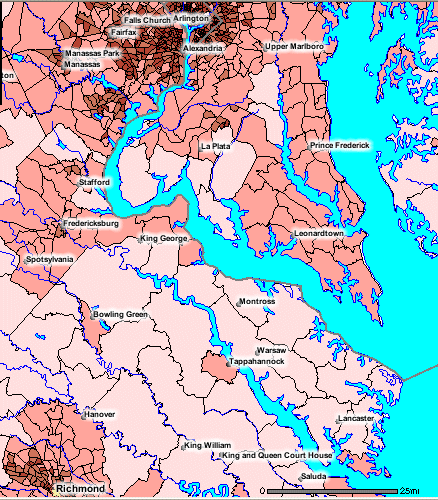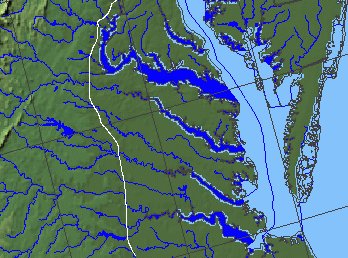
population density: Northern Neck vs. Northern Virginia
(areas shaded in darker red/darkest brown have higher population density)
Source: Chesapeake Bay Atlas - choose "CENSUS TRACT - Persons/sq mi"
Throughout the first century of European settlement, colonial Virginia failed to develop towns that were larger than those Indian towns. Instead, plantations along the river shorelines were the basis of community living.
Each plantation was a largely self-sufficient unit, able to feed itself and raise a "commercial excess" of tobacco for export. Plantations individually arranged for export of tobacco and import of items. Necessities and luxuries such as salt, sugar, wine, books, glass, china, mirrors, agricultural tools, and cloth for slave clothing would all be jumbled together in one shipment delivered to a plantation as much as a year after the order had been transmitted to England.
In the early days of colonization, "hundreds" and then individual family-based plantations were not models of democracy. The plantation owner was clearly in charge. Women, children, and especially slaves were subordinate to his direction. Society was a hierarchy; concentrations of people not under the control of a plantation owner (such as unemployed indentured servants or free blacks) were a threat. Democracy as we know it today was not perceived in the 1600's as an ideal. Instead, it was feared as a step towards mob rule, and the Virginia gentry was not interested in spurring the creation of population centers that might become the source of mobs and the refuge of thieves.
Colonial governors tried to create towns in Virginia by fiat, and the General Assembly passed numerous laws to encourage concentrations of settlement. Concentrating trade into a few towns would speed mobilization of the militia in times of foreign invasion, Indian attack, or slave revolt.
Towns would also facilitate collection of taxes. Ship captains were all supposed to pay taxes and get their papers approved by the officials, but smuggling was common - especially after passage of the Navigation Act of 1660, which supposedly eliminated direct trade between Virginia and ports in France, Holland, and even Scotland (until the 1707 Act of Union). In addition, English ship captains and their financial backers knew that transportation costs could be reduced, and shipping profits increased, if an entire cargo could be unloaded and loaded at just one or two stops.

So why were towns so slow to develop? Why is the population density on the Northern Neck and the Eastern Shore so low, 400 years after Jamestown, compared to the urban centers on the Fall Line?
The rivers were convenient and cheap international highways, and the road network in colonial Virginia was awful. Colonial Virginia lacked traffic jams - but it also lacked paved roads. (At Jamestown, oyster shells were scattered on a road surface to make it firmer, but there was no "base" or drainage designed to maintain the pavement.)
Dirt roads became swamps, impassibly-muddy quagmires after a few horses and wagons had used them. After the roads dried out, the ruts remained. Though there were few hills in Tidewater, all passengers and vehicles operated with, at most, a 4-horsepower "motor" that struggled to carry heavy loads on the poor roads. On occasion, wagons may have been pulled by 4 mules or 4 oxen. (Next time your car is slow to reach passing speed or merge into traffic, consider how the vehicles in colonial Virginia were underpowered...)
 Without the ability to ship it to England, tobacco was worthless. If the price was too low, farmers could eat the corn or hogs they raised - but no one ate tobacco. It was grown only to obtain cash and goods from overseas. Tobacco is also a heavy crop. Planters pressed or "prized" the leaves into barrels, or "hogsheads," that weighed up to 1,000 pounds. An entire growing season might be squeezed into two hogsheads, but the small planter still had to get these from the field or barn to a ship.
Without the ability to ship it to England, tobacco was worthless. If the price was too low, farmers could eat the corn or hogs they raised - but no one ate tobacco. It was grown only to obtain cash and goods from overseas. Tobacco is also a heavy crop. Planters pressed or "prized" the leaves into barrels, or "hogsheads," that weighed up to 1,000 pounds. An entire growing season might be squeezed into two hogsheads, but the small planter still had to get these from the field or barn to a ship.
Tobacco was a cash crop dependent upon export. It had minimal or no intrinsic value in Virginia. Settlement in Virginia grew along the edges of the Tidewater rivers first so tobacco growers could be sure the crop could be loaded onto ships. It took a century after Jamestown was settled before Governor Spotswood led the first expedition across the Blue Ridge, less that 100 miles westward, to stimulate real estate speculation deep in the colony's interior. (He concentrated his own investments at Germanna.)
It took another 25 years for the first cities to emerge at the Fall Line. During those 125 years, the Virginia gentry developed. Families who managed to acquire land grants along the James, York, Rappahannock, and Potomac rivers up to the Fall Line were able to raise a surplus of tobacco, import more indentured servants and (especially after 1700) more slaves. With increasing profits, they could buy more land and concentrate the colonial wealth into an upper class of powerful families, known as FFV's or "First Families of Virginia."
Such families started building large mansion houses to display their wealth after 1720, such as the Lee family home at Stratford Hall and the Byrd family home at Westover. Drive Route 5 between Richmond and Jamestown, and you'll see multiple signs inviting tourists to visit old colonial plantations along the James River. With what you've learned so far, are you surprised that these houses were built of brick (rather than limestone or marble), or that each is located within sight of the plantation's loading dock on a Tidewater river?
Urban centers did not become common in Virginia until the 1730's, after the population had grown substantially west of the Fall Line and the threat of foreign attack on coastal settlements had been diminished by the growth of the Royal Navy. When the General Assembly created municipal governments by granting town charters, it allowed the urban residents to assert more control over their communities.
Town government was desirable after quarterly meetings of the county courts were no longer adequate to deal with the development of lots and roads, or justice and social welfare conflicts. Some of the areas first settled by the English colonists never developed significant concentrations of people. The Eastern Shore, the Northern Neck, and the Middle Peninsula between the Rappahannock and York rivers are still dominated by rural farms and small towns, 400 years after colonization started.